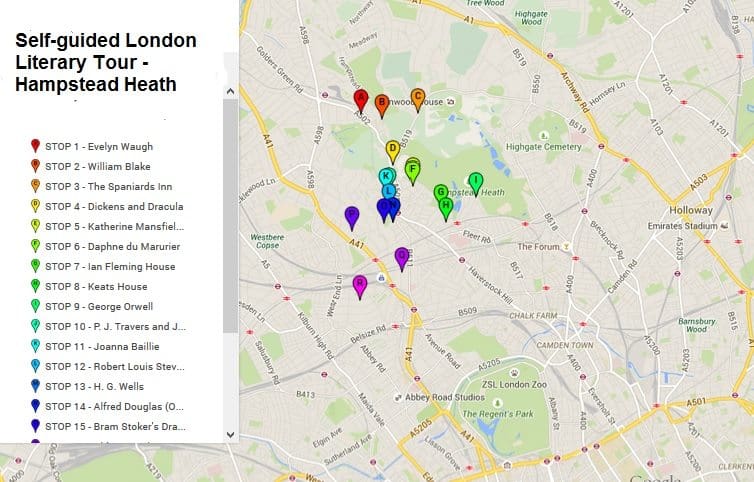London has been home to great literary authors for centuries. There are locations all over town connected to various authors and their works but this self-guided tour focuses on the north London location of Hampstead. Hampstead was a popular retreat for the wealthy from the late 1700’s into the mid-20th century and the houses here still command shockingly high property prices! Hampstead was the birthplace of big names in the literary industry such as A. A. Milne and Evelyn Waugh and is full of places for true literature lovers to explore.
Give yourself a solid 2 – 3 hours for this tour, as you will be walking quite a bit! The tour will take you through Hampstead and along Hampstead Heath so wear comfortable shoes. Hampstead is considered one of the more beautiful London boroughs so take time to enjoy the scenery – or even stop for a drink in one of London’s most well-known historical pubs.
Click for movable map.
START: Golders Green Station
EXIT Golders Green Station and turn LEFT onto N. End Road. Walk until you get to number 145.

Evelyn Waugh (1903 – 1966) was a British writer and journalist. Considered one of the leading English prose writers of the 20th century, Evelyn was born in Hampstead and lived here on and off throughout his life.
Best Known Works: Brideshead Revisited, Scoop, Vile Bodies (turned into the film Bright Young Things)
Continue down N. End Road in the same direction. You will come to Hampstead Way on your LEFT. Walk down until you get to the ‘Old Wyldes’ building.

One of the best known poets of the world, William Blake (1757 – 1827) was born in Soho, London and lived a portion of his life here in Hampstead. It was here that he met a group of artists that would lead him to branch out from poetry into painting and art.
Best Known Works: Cradle Song, A Poison Tree, To Spring, The Tyger, Auguries of Innocense, A Divine Image, Love’s Secret, The Angel
Follow Hampstead Way until it turns into Wildwood Road. On the RIGHT you will see a path that runs through Sandy Heath. Follow the path until you get to the main road – Spaniards Road. Turn LEFT toward the Spaniards Inn Pub.
STOP 3 – The Spaniards Inn [Spaniards Road, Hampstead]
The Spaniards Inn is a well-known historic pub perched right on the edge of Hampstead Heath. The pub was built in 1585 and was a popular haunt for highwaymen robbing coaches that used to travel along the road here through Hampstead. The literary connection here comes via Charles Dickens who mentions this pub in The Pickwick Papers and also Bram Stoker who mentions the pub in Dracula. Poets Keats and Bryon were drinkers here, as well, making this one of the most literary-connected pubs in town!
With your back to the pub, follow down Spaniards Road to your RIGHT. Continue walking until you get to a large yellow building on your right.
STOP 4 – Jack Straw’s Castle [N. End Way, Hampstead]
Another historic Hampstead pub is Jack Straw’s Castle. The pub itself was only built in the 1960’s but it is said that Jack Straw led a revolt against the king from this location in 1381. It is at Jack Straw’s Castle that Drs. Van Helsing and Seward dined in Dracula. The pub recently was turned into flats but the building’s name lives on and is mentioned in Harold Pinter’s play No Man’s Lane.
Continue down the main road, AWAY from Jack Straws Castle. Walk until you get to E. Heath Road and turn LEFT. Walk until you reach Number 17.
STOP 5 – Katherine Mansfield and J. M. Murray [17 E. Heath Road]
Katherine Mansfield (1888 – 1923) and her husband J. M. Murray (1889 – 1957) lived in this house throughout their marriage. While Murray was a noted literary critic, Katherine was a celebrated modernist short-fiction writer. She was friendly with other literary leaders like D. H. Lawrence and Virginia Woolf but her career was cut short when she unexpectedly died of tuberculosis at the age of 34.
Best Known Works: The Garden Party, The Fly, The Daughters of the Late Colnel, The Garden Party
Now go back on yourself for a few steps and then turn LEFT onto Squire’s Mount. Then take a RIGHT onto Cannon Place. Walk until you reach Number 14.
STOP 6 – Daphne du Maurier [14 Cannon Place]
Dame Daphne du Maurier, Lady Browning (1907 – 1989) was born in Cornwall but lived her childhood in this house here in Hampstead. Her father, Sir Gerald du Maurier, owned the house and lived here from 1916 until his death in 1934. Canon Hall was recently placed on the property market in 2014 with an asking price of £32million!
Best Known Works: These days Daphne is known more for her stories that were turned into films: Rebecca, Jamaica Inn, The Birds, Don’t Look Now
Continue in the same direction town Cannon Place and turn LEFT onto Christchurch Hill. Continue walking until Christchurch Hill turns into Willow Road (right where you will begin walking along the park). Stop at Number 2.
STOP7 – Ian Fleming [2 Willow Road]
Ian Fleming ( 1908 – 1964) almost needs no introduction. As the author and creator of James Bond, Ian Fleming’s work is still incredibly popular and accessible to the public of today. Number 2 Willow Road is surrounded by two other buildings all connected into a single unit. Numbers 1 and 3 are privately owned but Number 2 is now run by the National Trust which contains an art collection that is open to the public.
And who designed this group of buildings? A modernish architect named Erno Goldfinger! He had to knock down a number of cottages to create the building that stands here now – a decision which was extremely unpopular with many residents, such as Fleming. Who obviously got his revenge by naming one of the greatest Bond villains after Erno!
Best Known Works: James Bond
Continue in the same direction you were walking in and make the RIGHT onto Downshire Hill. Then take the first LEFT onto Keats Grove where you’ll come to your next stop.
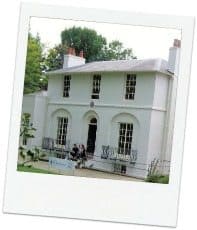
John Keats (1765 – 1821) is one of England’s best-known romantic poet. His popularity did not truly grow until after his death – an early one, at age 25 - but today his works are some of the most popularly enjoyed and analysed all over the world. The house here was not actually owned by Keats; he moved in with his friend, Charles Brown, who was living here in 1818. It is said that Ode to a Nightingale was written in the garden here and living next door at the time was Fanny Brawne who Keats fell in love with and became engaged to.
Best Known Works: Ode to a Nighingale, Ode on a Grecian Urn, La Belle Dame Sans Merci, On Autumn
Now you have two options. From here it is possible to take a small journey up to Parliament Hill to see George Orwell’s House. Or you can continue the walk without the detour.
To see George Orwell’s House: The road that surrounds Keats House is Heath Hurst Road. Follow that road around the House and cross over at the junction with S. End Road. Go FORWARD and when the road splits, take the RIGHT arm onto Parliament Hill. Walk up the road until you get to Number 77.
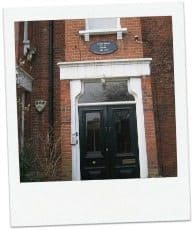
Born Eric Arthur Blair, George Orwell (1903 – 1950) was one of the greatest authors of his generation. His works tackle issues of social injustice, socialism, totalitarianism and war. He lived in the building here and worked in a shop on this site for a short period, only 1934-5 but the plaque here is a monument to his greatness with a life-like carving of his head attached!
Best Known Works: Nineteen Eighty-Four, Animal Farm, Down and Out in Paris and London, Homage to Catalonia
Now go BACK on yourself down Parliament Hill. Turn LEFT onto S. End Road then RIGHT onto Pond Street. Walk past the hospital and take the second LEFT onto Rosslyn Hill. Continue walking until you get to Hampstead Station.
To skip George Orwell’s House: Get back onto Keats Grove and walk back on yourself to DOwnshire Hill. Turn LEFT and walk until you get to the main road, Rosslyn Hill. Turn RIGHT and walk up the hill until you get to Hampstead Station.
The road continues past Hampstead Station and splits into two – Take the LEFT road, Holly Hill. Walk up Holly Hill until the road splits AGAIN and take the RIGHT road, Hampstead Grove. Walk up (passing Fenton House on your left) until you get to Admiral’s Walk. Here turn LEFT until you get to the Admiral’s House. You’ll recognise it because it is shaped like a ship!
STOP 10 – P. J. Travers and John Galsworthy [Admirals House, Admirals Walk]
Admirals Walk contained the houses of two large literary figures: John Galsworthy (1867 – 1933) novelist and playwright and P. L. Travers (1899 – 1996) novelist and journalist. Galsworthy won a Novel Prize in Literature in 1932 and lived the majority of his life here in Hampstead. He died in this house from a brain tumour in 1933.
Next door to John Galsworthy is the former house of P. L. Travers. Born Helen Lyndon Goff, Travers moved to England from Australia in 1924 and a decade later her novel, Mary Poppins, was completed. Her fame became international during World War II when she was approached by the Disney company to turn her story into a film, which was released in 1964. You may notice that Admiral’s House is shaped like a ship – much like the house the Banks’ family live next to in the story/film!
Galsworthy’s Best Known Works: The Forsyte Saga, Over the River, The First and the Last (Turned into the film 21 Days)
- L. Traver’s Best Known Works: The Mary Poppins Series
Continue walking past Admirals House and take the first LEFT onto Windmill Hill. Walk until you see Bolton House with a brown plaque commemorating Joanna Baillie.
STOP 11 – Joanna Baillie [Bolton House, Windmill Hill]
Scottish poet and dramatist Joanna Baillie (1762 – 1851) spent most of her adult life here in Hampstead. She was widely known not just for her literary works but for her kind and sweet disposition as well as her intelligence. She held a literary society at her home here in Hampstead and it was in this building that she died at age 88 in 1851.
Best Known Works: Plays on the Passions
Keep walking down Windmill Hill. The road will take you past Fenton House again and will merge with another street, Frognal Rise. Keep walking until you can take a RIGHT onto Mount Vernon. Walk until you get to Number 7.
STOP 12 – Robert Louis Stevenson [7 Mount Vernon]
Widely celebrated throughout his life, Robert Louis Stevenson (1850 - 1894) continues to be a powerful force in the literary world and ranks as one of the 26 most translated authors in the entire world. Stevenson lived in Hampstead for years and described Hampstead as, “the most delightful place for air and scenery in London.”
Best Known Works: Treasure Island, Strange Case of Dr Jekyll and Mr Hyde, Kidnapped
Continue following Mount Vernon until you can make a LEFT onto Holly Walk. Continue going and make the first LEFT onto Church Row. Stop at Number 17.

Church Row is considered by some to be the most picturesque and beautiful roads in all of London. H. G. Wells (1866 – 1946) thought so, too, which is why he moved into this seven-bedroom house in 1909. However, once here his family realised that a constant stream of funeral carriages would process past their house to and from the church at the end of the row! Eventually, this is why they moved out in 1912.
Best Known Works: The Time Machine, The Invisible Man, The Island of Doctor Moreau, The War of the Worlds
Stay on Church Row and move onto Number 26.

Lord Alfred Douglas (1870 – 1945), known by his nickname Bosie, was an author and poet himself but perhaps far better known for his affair with world-famous writer and wit Oscar Wilde. Bosie moved into the house here in 1907, long after Oscar Wilde had died.
Best Known Works: Two Loves (which features the now-famous line, in reference to homosexuality, “the love that dare not speak its name.”)
Now walk BACK on yourself toward Hampstead Parish Church. The churchyard and cemetery here are your next stop.
STOP 15 – Bram Stoker’s Dracula [St. John-at-Hampstead Parish Church, Church Row]
The church here is sitting on a site that has had a house of worship on it since the 14th century, but the current building is a 1740’s design. But it’s the churchyard and cemetery here that gives the building its’ literary connection. The churchyard here is the burial place of a number of writers: Walter Besant, Peter Cook, George du Maurier, Gerald du Maurier, and Evelyn Underhill.
Perhaps most famously, however, it is believed that this is the churchyard in which Bram Stoker was writing about when Lucy Westenra was buried in a vault in Dracula. Because of this the churchyard is often visited by Dracula-fans and it is also, obviously, thought to be haunted!
With your BACK to the church take the exit out of the churchyard on your LEFT which will bring you onto Church Row again, but at a different part. Turn LEFT onto Frognal Street and take the first RIGHT onto Frognal Lane. Walk until you get to Bracknell Gardens and turn RIGHT. Walk to Number 16.
STOP 16 – Aldous Huxley [16 Bracknell Gardens]
Novelist, humanist and essayist, Aldous Huxley (1894 – 1963) only lived in Hampstead for a short period of time in 1919 to 1920 but his international fame and cult=-like following means that this is a popular place for tourists to come.
Best Known Works: Brave New World, Island, The Doors of Perception
Now go back on yourself toward Frognal Lane and turn LEFT. Take the first RIGHT onto Langland Gardens and then the first LEFT onto Lindfield Gardens. When the road ends at Arkwright Road turn LEFT. Walk until it ends at Fitzjohn’s Avenue and turn RIGHT. Follow the road until you can turn RIGHT onto Nutley Terrace. Take the first LEFT onto Maresfield Gardens and stop outside the Freud Museum.
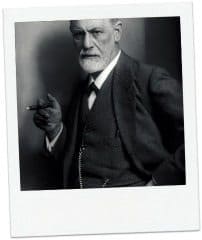
Sigmund Freud {1856 – 1939) was a neurologist and the “father of psychoanalysis” but he has his place on this list because of his notoriety and his publishing work. Freud created psychoanalysis – a clinical method of treating psychopathology – and also formulated his own psychoanalytical theories such as the Oedipus complex. His work is published, known and studied throughout the entire world. He lived in Hampstead for the last year of his life and his daughter, Anna, continued to live in the house until her death in 1982. The building was opened to the public as a museum in 1986.
Continue in the same direction down Maresfield Gardens. When the road starts to curve toward your LEFT, take the small pathway on the RIGHT which takes you onto the main road, Finchley Road. Turn RIGHT and walk toward the Waitrose Supermarket. Cross Finchley Road and walk down Canfield Gardens with the Waitrose on your LEFT. Continue walking AWAY from the main road until you can turn RIGHT onto Fairhazel Gardens. Then take the first LEFT onto Compayne Gardens. Stop at the Fairhurst Building.
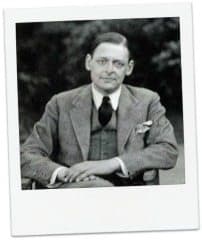
Essayist, literary and social critic, publisher and playwright, T. S. Eliot [1888 – 1956] was celebrated throughout his life and could count a Nobel Prize in Literature as one of his achievements. His poems are perhaps some of the best known in the English language. Although born in the United States, Eliot came to England and studied at Oxford. He routinely came to London and married his first wife Vivienne Haigh-Wood at Hampstead Registry office in 1915. He then moved into his in-laws house here at Compayne Gardens, although he is quoted as saying that this house was “gloomy, with long dark corridors.”
Best Known Works: The Love Song of J. Alfred Prufrock, The Waste Land, Four Quartets
Continue in the same direction until the road ends and you can turn LEFT onto West End Lane. Make a RIGHT and this will take you to West Hampstead where the walk ends.
FINISH: West Hampstead Station







